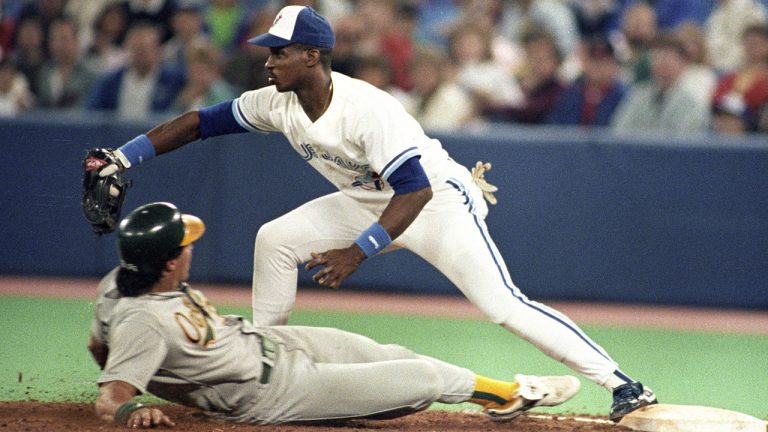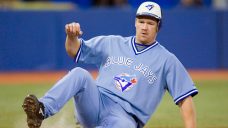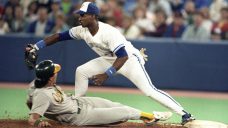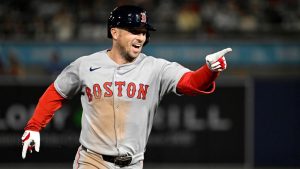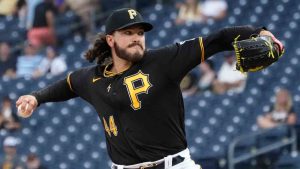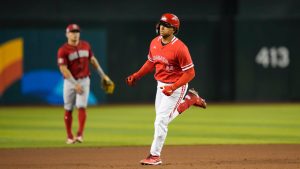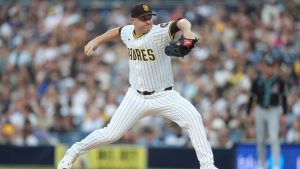COOPERSTOWN, N.Y. — In the summer of 1981 Cito Gaston, then a minor-league hitting instructor in the Atlanta organization, took a phone call from his former teammate, friend and boss, farm director Hank Aaron. The legendary slugger had heard some murmurs about a New York Yankees draft pick playing rookie ball in Bradenton, Fla., named Fred McGriff and wanted some intel. Got anything?
"'If you ever get a chance to get him, get him,'" Gaston remembers telling Aaron. "'Freddie is hitting ball in the cages there so far it’s unbelievable.'"
McGriff ended up with Atlanta 12 years later, but not before Gaston moved to the Toronto Blue Jays, first as hitting coach in 1982 before taking over as manager in 1989, and got his guy when Hall of Fame general manager Pat Gillick pulled off one his many signature trades. The Yankees, seeking reliever Dale Murray, sent the hard-hitting first baseman, just 19 at the time, with Dave Collins and Mike Morgan to the Blue Jays for the righty and Tom Dodd during the 1982 winter meetings.
Three seasons later, McGriff touched the big-leagues, beginning a career as a middle-of-the-order force renowned for a remarkable consistency set to be recognized Sunday with induction to the Hall of Fame.
During McGriff’s five seasons with the Blue Jays, Gaston watched that rookie ball potential blossom into all-time greatness.
“Freddie should have been in a long time ago,” says Gaston. “Good eyes for a big man and big guys usually don't have good eyes — they swing at bad pitches. They're trying to get ready in a hurry because they've got a little bit of a longer swing. But Fred had great eyes up there, Frank Thomas had great eyes up there, John Olerud had good eyes up there. They swing at strikes. When you swing at strikes you certainly have a better chance to hit the ball hard somewhere, and he just was a great hitter, really. I'm very happy for him.”
McGriff was voted into the Hall through the Contemporary Era committee after passing through his eligibility on the Baseball Writers Association of America ballot unelected. He enters alongside Scott Rolen and together they join eight other players with ties to the Blue Jays in Cooperstown — Phil Niekro, Dave Winfield, Paul Molitor, Rickey Henderson, Roberto Alomar (who has since been placed on MLB’s ineligible list after an allegation of sexual misconduct was investigated and reviewed by commissioner Rob Manfred), Frank Thomas, Jack Morris and Roy Halladay. Gillick and former manager Bobby Cox, who brought Gaston with him to Toronto, are also enshrined, while broadcaster Tom Cheek is a Ford C. Frick award winner.
Rolen’s time with the Blue Jays was short but impactful, playing on the 2008 team that should have made it to the post-season and helping, both directly and indirectly, the organization land Jose Bautista and Edwin Encarnacion.
“It was a transitional period in my career and I appreciated the Blue Jays coming after me and getting me in there in kind of a new role (as a veteran leader) and see if we could steady the ship,” he says. “It's a shame I got hurt and we didn't get over the hump but met some incredible people.”
Though McGriff is often remembered for a brilliant five-year stretch with Atlanta alongside fellow Hall-of-Famers Greg Maddux, Tom Glavine, John Smoltz and Chipper Jones, it was with the Blue Jays that his remarkable run of steadiness began.
The first three of his seven straight years with 30 home runs happened with the Blue Jays, although his eight seasons with 100 RBIs all came with other clubs. Still, it was in those early years that the mindset that helped carry him to a .284/.377/.509 career batting line along with 493 home runs and 1,550 RBIs took hold.
“I tried to set goals for myself and that kept me down to Earth, even when times got tough,” he says. “I told myself if I could hit five home runs a month, I end up with 30 homers. If I get 17 RBIs a month, I have 100 at the end of the year. And if you go 3-for-10, you hit .300, which is very tough to do, but that was always my goal.
"If you're having a bad month and only have a couple of home runs and it's getting to the middle of the month, you still say to yourself, come on, just three good swings to keep you going.”
That thought process served him well, especially given the roster logjam during his first full season in the majors in 1987.
McGriff and Cecil Fielder — acquired from the Kansas City Royals in February of 1983 for part-time outfielder Leon Roberts in another of Gillick’s steals — had chased each other through the system and graduated to the majors together onto a team that already included Willie Upshaw at first base, DH option Rick Leach and would later add Juan Beniquez to the mix, too.
“We had like five first basemen, really crazy,” remembers Gaston, “but Freddie handled it pretty well.”
Key to that was the friendship McGriff and Fielder had built on the way up, which could easily have become adversarial given that they both played first base. But “it was great because Cecil was a good person, good man, we used to play cards all the time,” says McGriff. “We had Willie Upshaw, who was a stud so you knew you had a little roadblock here and there, but all you could do was just go out there and play.
"It ended up working out great for me because my first year we DH'd, I played against the right-handed pitchers, Cecil played against left-handed pitchers and Upshaw was still playing first base every day. The Blue Jays broke me in slowly, they didn't rush me up there, I was hitting seventh and eighth and when you got George Bell, Jesse Barfield, all those guys hitting in front of you, what I did was just icing on the cake.”
Gaston mentored them both through the challenges, working with them on their approaches at the plate — he wore McGriff out telling him to get into his back leg as he’d launch into his pretty, high-finish swing — as well as on their defence. An outfielder throughout his big-league career, one winter while playing in Venezuela he was picked as the all-Caribbean first baseman, and he’d use the special glove he was awarded to tease both until they decided they’d had enough.
“I’d say, 'You guys play down there all the time, you ever been all-Caribbean first baseman? I was an outfielder. How could you not be all-Caribbean first baseman?' And I'd show them the glove every day,” says Gaston. “They got tired of hearing about it and all of a sudden that glove disappeared and they burned it up. I never found it because they set it on fire. Cecil told me about it a few years ago. I figured they had something to do with it but I didn't know they burned my glove up.”
By 1988, the other thing McGriff was burning up was big-league pitching, taking over from Upshaw at first base while Fielder remained a part-time DH. At the end of that year, that led to Fielder being sold to the Hanshin Tigers in Japan — paving the way for his emergence as the 51-homer “Big Daddy” with the Detroit Tigers — while allowing McGriff to really settle in.
A 36-homer, 92-RBI, 119-walk campaign in 1989 led to a sixth-place finish in AL MVP voting and the first of three Silver Slugger awards, although that summer the Blue Jays drafted Olerud in the third round, and his arrival in the majors that summer recreated the roster logjam McGriff had graduated into.
As Olerud began to emerge in 1990 and the Blue Jays spun their wheels in the standings, Gillick made his most celebrated trade, sending McGriff and shortstop Tony Fernandez to the San Diego Padres for Joe Carter and Alomar. The blockbuster deal that drew gasps when announced at the winter meetings that December famously prompted Gillick’s wife Doris to implore him to “come home before you screw up the team more,” but also worked out brilliantly for the Blue Jays and, eventually, McGriff.
The Blue Jays won the World Series in 1992 and ’93 while McGriff, after being traded from San Diego to Atlanta during a Padres sell-off, got his championship in 1995.
“We’re looking for a right-hand hitter,” says Gillick. “We had John Olerud who could play first base and so he and Freddie would either have to play first base and DH, and so we just thought well we might be better getting a right-handed hitter in our lineup so consequently that was the intention.
“We probably would have done a McGriff for Carter one-for-one but it was the third suggestion by San Diego that I asked them if they would talk about Alomar. And they said, well if you would talk about Fernandez, and so that’s the one that got going.”
Through that trade and beyond, McGriff just kept going, putting up his 30 and 100 so quietly and consistently that it was almost taken for granted. He lacked the flash of other sluggers, some tainted, in his era, like Barry Bonds, Jose Canseco, Mark McGwire and Sammy Sosa, but for two decades put up his numbers, riding his trademark stoicism to damage in the batter’s box.
“Freddie was always nice and calm, stays cool, doesn't get excited by anything. That's what it takes,” says Gaston. “That's like Big Daddy (Fielder), he was the same way. Good hitters are calm. Even though Pete Rose looked like he was in a hurry all the time, he was calm when he was at the plate, you know what I mean? Hank would walk up there real slow, pull his helmet on over his cap and then the next thing, he'd hit a fastball and explode on it. That's the way Fred was, nice and calm. He knew the pitcher was in trouble, he wasn't in trouble.”
Inherently, McGriff understood that.
From getting cut from his high school team as a sophomore, to being drafted and traded by the Yankees, working through a logjam with the Blue Jays, resets with the Padres, Atlanta, his hometown Tampa Bay Devil Rays, the Chicago Cubs and Los Angeles Dodgers, he remained level and found ways to produce.
“Baseball is very tough, you're going to have your peaks and valleys,” he says. “But if you can stay even-keel you've got a chance for success. And I still look to this day and the guys that were able to stay even-keel, they survived in the big-leagues. A lot of the hot-tempered guys don't make it because it's too much of a roller-coaster ride.”
McGriff didn’t ride the roller-coaster and after a long wait, he’s in Cooperstown.
